外研版高中英语必修一第四模块教学设计1
- 格式:doc
- 大小:59.00 KB
- 文档页数:8
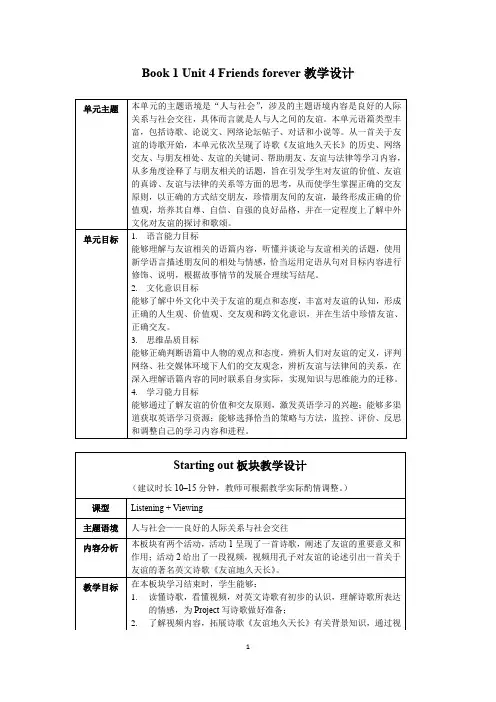
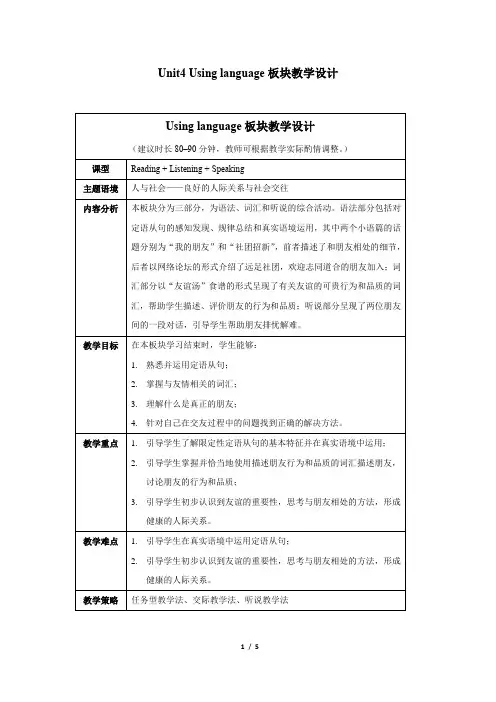
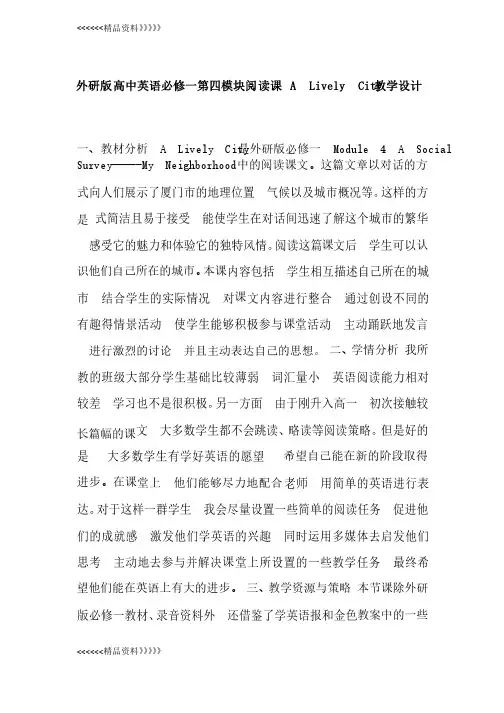
<<<<<<精品资料》》》》》<<<<<<精品资料》》》》》外研版高中英语必修一第四模块阅读课 A Lively City 教学设计一、教材分析一、教材分析 A Lively City A Lively City 是外研版必修一是外研版必修一 Module 4 A Social Module 4 A SocialSurvey-----My Neighborhood 中的阅读课文。
这篇文章以对话的方中的阅读课文。
这篇文章以对话的方是课认识他们自己所在的城市。
本课课课二、学情分析学情分析我所长篇幅的课希望自己能在新的阶段取得进步。
在课课望他们能在英语上有大的进步。
望他们能在英语上有大的进步。
三、教学资源与策略教学资源与策略本节课除外研教案中的一些要采用的教学策略有要采用的教学策略有: : 任务型阅读教学法和交际式教学法。
任务型阅读教学法和交际式教学法。
四、教学目标学目标 1. 1. 1 2文章大意并能完成相应阅读任务。
3) 能够复述文章并介绍自己的城能够复述文章并介绍自己的城市。
2. 1)课堂活动2)用所学知识进行语言表达。
用所学知识进行语言表达。
3. 3. 通过本模块操。
操。
五、教学重难点五、教学重难点 1. 1. 1) 学会利用跳读、略读等阅学会利用跳读、略读等阅 2) 正确理解文章主题大意及细节信正确理解文章主题大意及细节信息。
息。
2. 2.1) 课文。
2) 六、教学过程过程 教学环节教学环节 教师活动教师活动 Review some words and expressions by Review some words and expressions by having students describing their own houses and city. Then showsome beautiful pictures of a city to have them use someadjectives to describe so as to lead in the topic A Lively City.Have students discuss and predict 学生活动学生活动 1. 1.Take part in the activity actively 2. Apprreciate these pictures and discuss some questions 设计意图 Step One Leading-in Step TwoDiscussion Discuss and 通过简单的描述来复习上节课的词汇既能快速将学生带入课进而通过图片的展示让学生试着用恰当的形容词来描绘这课题课题---A Lively City ---A Lively City。
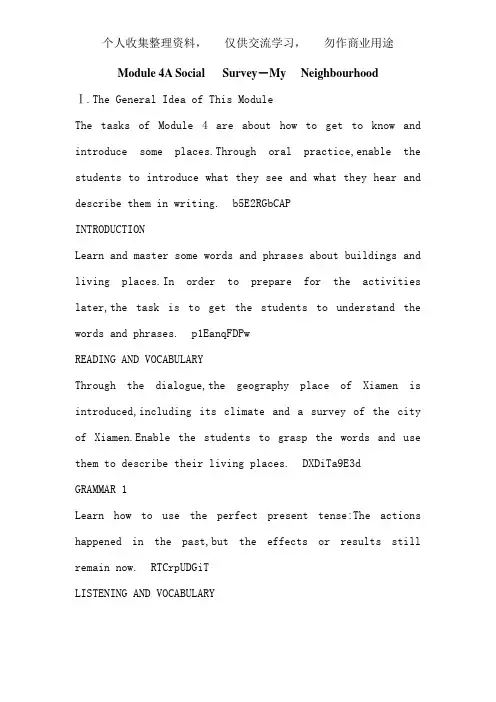
Module 4A Social Survey-My NeighbourhoodⅠ.The General Idea of This ModuleThe tasks of Module 4 are about how to get to know and introduce some places.Through oral practice,enable the students to introduce what they see and what they hear and describe them in writing.b5E2RGbCAPINTRODUCTIONLearn and master some words and phrases about buildings and living places.In order to prepare for the activities later,the task is to get the students to understand the words and phrases.p1EanqFDPwREADING AND VOCABULARYThrough the dialogue,the geography place of Xiamen is introduced,including its climate and a survey of the city of Xiamen.Enable the students to grasp the words and use them to describe their living places.DXDiTa9E3dGRAMMAR 1Learn how to use the perfect present tense:The actions happened in the past,but the effects or results still remain now.RTCrpUDGiTLISTENING AND VOCABULARYPractice using the words and phrases,train the students’ listening ability and test the results of listening.5PCzVD7HxAGRAMMAR 2The importance of Grammar 2 is about the differences between continuous verbs and discontinuous verbs and how to use them in the Present Perfect Tense.First make sure the students clear what is a continuous verb and what is not a continuous verb. Fox example,He has come here.He has been here for two hours.Here“come” is not a continuous verb. But “be” is a continuous verb. jLBHrnAILgPRONUNCIATIONThis part is to improve the students’ pronunciation.Stress is important in speaking English.The students should master Parts of Speech.Generally speaking,the National Parts have stress in a sentence.But the Structural Parts don’t have.xHAQX74J0XWRITINGThrough observing and writing,make sure that the students can use the words and and but.LDAYtRyKfEEVERYDAY ENGLISHIn the part the students practice using seven pieces of everyday English.During teaching,practice using them in conscious or unconscious.Zzz6ZB2LtkFUNCTION AND SPEAKINGThe students should learn and master how to introduce directions and places in English in this part.dvzfvkwMI1CULTURAL CORNERIncrease the students’ interests to know something about the life in western countries.rqyn14ZNXITASKSThrough the practice of dialogue and reading,the students should be able to master some useful words and expressions about describing buildings and surroundings.In order to cultivate the students’ ability of collecting and dealing with information,and develop their abilities in getting new information,communication and cooperation,the tasks are about a survey of their living situation and they are also asked to write a report in English.EmxvxOtOcoⅡ.Three-Dimensional Goals1.Knowledge and Skills:2.Through introducing some places,develop the students’ abilities to take active part in differentactivities.Train the ability of collecting and dealing with information,and develop their abilities of getting new information,communication and cooperation.SixE2yXPq53.Process and MethodsFirst lead the students to make dialogues about different buildings and facilities.Then ask the students to survey their living places and write down what they see and hear to improve the students’ speaking and writing abilities.6ewMyirQFL4.Emotion,Attitude and Value in TeachingLet students know the society,develop the students to care for the people around them and the society.Cultivate their ability of studying and solving questions.kavU42VRUsⅢ.Teaching Important PointsIn this module,through practicing listening,speaking and reading,the students will be able to get to know and introduce some cate the students’ cultural awareness and enable them to love our hometown and our homeland. y6v3ALoS89Ⅳ.Teaching Difficult PointsHow to teach the Present Perfect Tense during teaching process.M2ub6vSTnPⅤ.Teaching Aidsmultimedia,a TV set or a recorderⅥ.Teaching TimeSeven periodsThe First Period:Introduction:Vocabulary and Speaking0YujCfmUCwThe Second and Third Period: Reading and Vocabulary eUts8ZQVRdThe Fourth Period:Grammar 1,Listening and Vocabulary sQsAEJkW5TThe Fifth Period:Pronunciation,Grammar 2 and Writing GMsIasNXkAThe Sixth Period:Everyday English,Function and Speaking TIrRGchYzgThe Seventh Period:Cultural Corner,Task and Module and Workbook Exercises7EqZcWLZNXThe First PeriodThe General Idea of This PeriodThe students will be able to learn some new words and phrases.And try to use them to describe buildings.lzq7IGf02ETeaching Aims1.The students will be able to learn and master the following words and phrases: zvpgeqJ1hkflatapartment blockcountrysidefive-storeyhigh-risebuildinglocalmilefloorsuburbstonesurveybe similar to live with sb. /sthneighbourhoodNrpoJac3v12.Improve the students’ speaking’ ability.3.Learn to describe some buildings and places.Teaching Important Points1.Master the new words and phrases.2.How to use “and” and “but”.3.Enable the students to write a brief report of their neighbourhood. 1nowfTG4KITeaching Difficult Points1.How to use “and” and “but”.2.How to impro ve the students’ writing ability.Teaching Methods1.Asking and answering activity to help the students go through the reading materials.fjnFLDa5Zo2.Individual,pair or group work to make every student work in class.tfnNhnE6e5Teaching ProceduresStep 1 Greetings and lead inT: Good morning,boys and girls.S: Good morning,teacher.T: Sit down please.Boys and girls,let’s see two pictures.(Show the pictures>HbmVN777sLT: Please tell me something about the pictures?S: One is about the buildings in cities.The other is the countryside.V7l4jRB8HsT: Yeah.Which one is more beautiful?Why?S: I think the right one is.It is modern.T: How many floors do you guess the big one has?S: I guess it’s about 80.T: Do you agree?S: No.I think it’s about 30.T: If possible,which floor do you want to live in?S: The top one.T: The top one?Why?S: Live there,I can see the whole city.T: Try.I think you can one day.Step 2 PresentationNow let’s look at these words.(Show>1.Get one to read the words.Check his or her pronunciation and stress.83lcPA59W92.Get the students to pay attention to the new words.mZkklkzaaP(1>survey n.The group made a survey of the life in the countryside.AVktR43bpwThe experts made a survey of the site of the prospective steel works.ORjBnOwcEdThe report gives a survey of growth of the chemical industry.2MiJTy0dTTThe market __________shows the new products have good potential if they are well developed. gIiSpiue7AA. madeB. supportC. surveyD. examine答案:C。
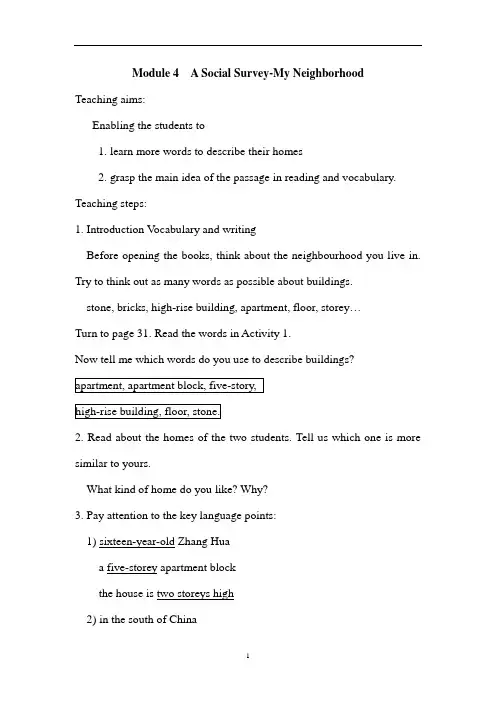
Module 4 A Social Survey-My Neighborhood Teaching aims:Enabling the students to1. learn more words to describe their homes2. grasp the main idea of the passage in reading and vocabulary. Teaching steps:1. Introduction V ocabulary and writingBefore opening the books, think about the neighbourhood you live in. Try to think out as many words as possible about buildings.stone, bricks, high-rise building, apartment, floor, storey…Turn to page 31. Read the words in Activity 1.Now tell me which words do you use to describe buildings?2. Read about the homes of the two students. Tell us which one is more similar to yours.What kind of home do you like? Why?3. Pay attention to the key language points:1) sixteen-year-old Zhang Huaa five-storey apartment blockthe house is two storeys high2) in the south of Chinain the northeast of the city4. Turn to page 32. Reading and V ocabulary.First look at the picture. Do you know where this place is?Have you ever been to Xiamen or have you heard Xiamen?What do you know about it?Suppose I want to know something about a city. What should you tell me about it?Listen to the tape of the text and make a note of what you think is important about Xiamen.5. Read the passage and answer the following questions:1.) Who is visiting whose hometown?2.) Where does Xiao Li live?3.) What’s the climate/weather like there?4.) Which district is the most interesting part of Xiamen?5.) What is Gulangyu Island like?6. Try to finish Activity 1 and Activity 2.7. Read the text again and try to say something about the livelycity-Xiamen.8. Ask some to tell about the city with the help of this clue.hometown→beautiful cities→friendly →fortunate→climate→apartment→business district→shopping malls→dress →present→harbor→district→island→restaurant.9. Homework:1) Read the passage several times to get more familiar with the information in it.2) Try to retell about the city.。
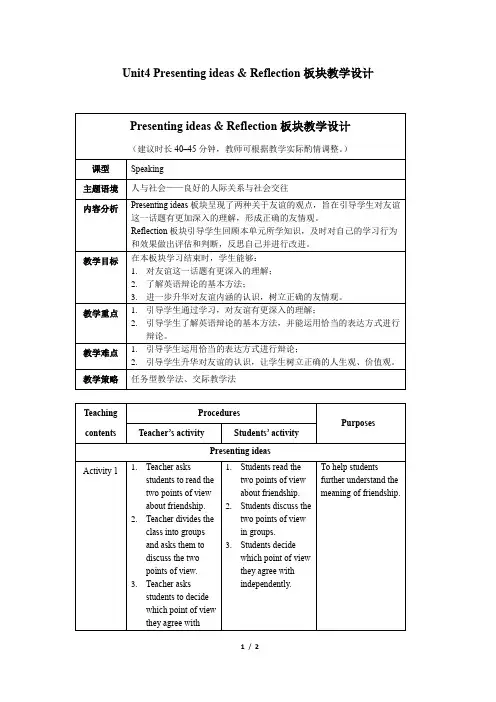
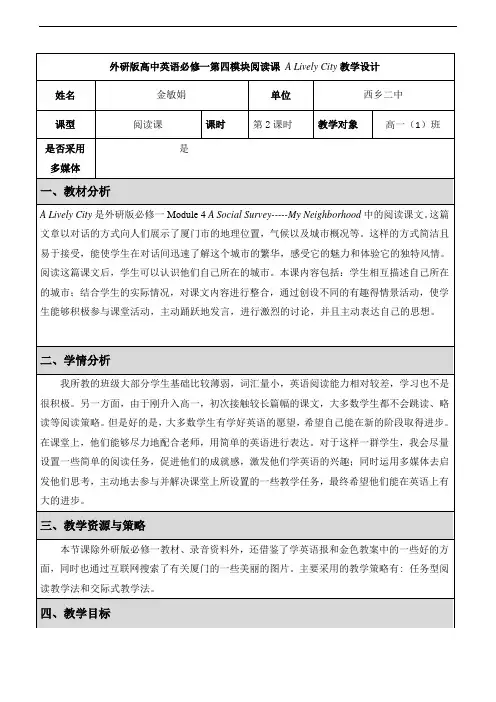
专家点评(交大附中陈江丽)
1. 教材分析和学情分析比较到位,能够深入细致地分析教材的内容和学生英语学习的基础。
2. 教学目标定位不准确。
教学目标中的知识技能目标提到“掌握文中的词汇和语言点”。
在后边
的教学环节中没有显示为了让学生掌握文中的词汇和语言点教师做的教学活动。
3. 在阅读环节中教师设计很多教学活动。
例如第一次阅读后的活动是根据文章填空和正误判断;
第二次阅读的活动是回答问题和填空。
总体来看,这些教学活动有很多重复的地方。
每次阅读的策略不同,教师的阅读后活动也应该不相同。
例如在第一次阅读后,通常都会设置main idea 的问题;在第二次scanning阅读后,通常会设计有关文章细节信息的问题,目的是让学生尽快熟悉文章。
第三次阅读后设置一些深层次理解的问题。
例如评价性问题,发散思维的问题等,目的是让学生能够用所学的语言做事。
教师的阅读策略和方法应该与读后活动相匹配。
活动应该突出梯度性,不应该是原地踏步的活动多次出现。
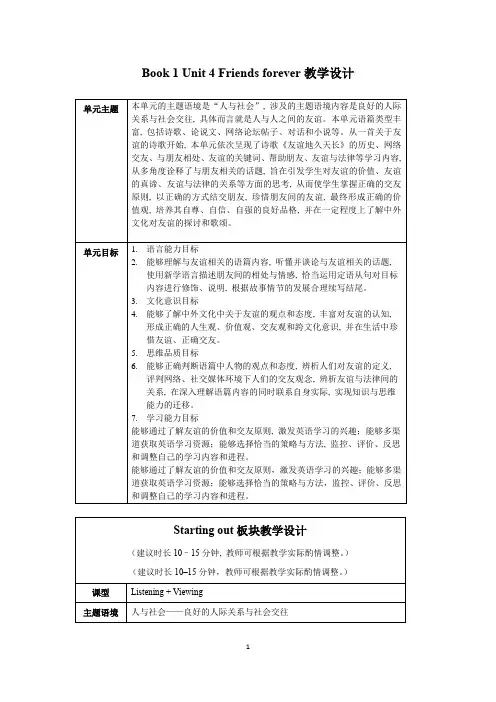
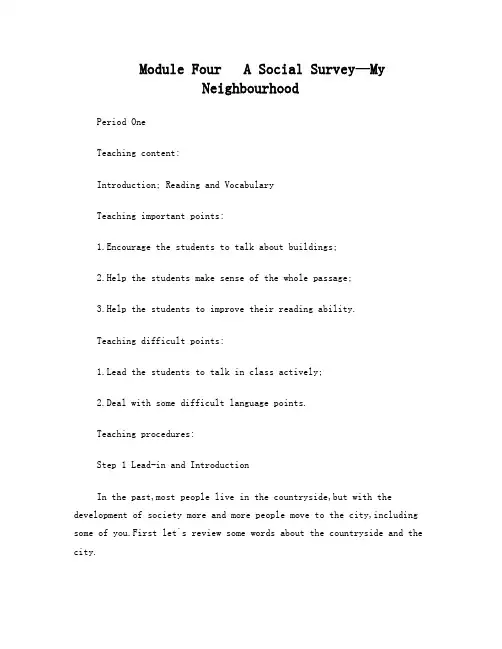
Module Four A Social Survey—MyNeighbourhoodPeriod OneTeaching content:Introduction; Reading and VocabularyTeaching important points:1.Encourage the students to talk about buildings;2.Help the students make sense of the whole passage;3.Help the students to improve their reading ability.Teaching difficult points:1.Lead the students to talk in class actively;2.Deal with some difficult language points.Teaching procedures:Step 1 Lead-in and IntroductionIn the past,most people live in the countryside,but with the development of society more and more people move to the city,including some of you.First let`s review some words about the countryside and the city.village, countryside, town, suburb, apartment(AE)/flat(BE), block, community, neighbourhoodThis module,we`ll talk about our neighbourhood.Now,please turn toP31 to learn more words about this topic.1.Activity1 on P31.2.Activity2 on P31.3.Activity3 on P31.(It can be assigned as home work.)Ask the students to write some sentences describing their homes after the example and then ask some of them to present their work to the class.Step 2 Pre-readingNext we`ll listen to the tape about Xiao Li`s hometown and choose the correct answers.(Activity1 on P33)Step 3 Reading1.Activity2 on P332.Explain some language points.(Ref: Notes to the text.)3.Read through the text carefully again to understand it better.Step 4 Consolidation[Finish Activity3-4 not referring the text to test how much the students can remember about the text after reading.]4.Activity3.5.Activity4.Step 5 Summary and Homework1.Summary: Summarize what they have learned in this period.2.Homework: Reading on P87-88 in workbook.Appendix: Notes to the text1. It’s been six years since we last s aw each other. 自从我们上次见面已经有6年了。
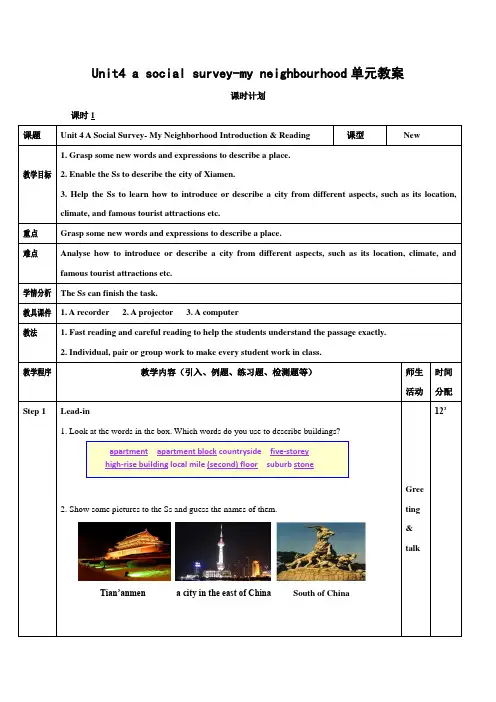
Unit4 a social survey-my neighbourhood单元教案课时计划课时1课题Unit 4 A Social Survey- My Neighborhood Introduction & Reading 课型New教学目标1. Grasp some new words and expressions to describe a place.2. Enable the Ss to describe the city of Xiamen.3. Help the Ss to learn how to introduce or describe a city from different aspects, such as its location, climate, and famous tourist attractions etc.重点Grasp some new words and expressions to describe a place.难点Analyse how to introduce or describe a city from different aspects, such as its location, climate, and famous tourist attractions etc.学情分析The Ss can finish the task.教具课件 1. A recorder 2. A projector 3. A computer教法 1. Fast reading and careful reading to help the students understand the passage exactly.2. Individual, pair or group work to make every student work in class.教学程序教学内容(引入、例题、练习题、检测题等)师生活动时间分配Step 1 Lead-in1. Look at the words in the box. Which words do you use to describe buildings?2. Show some pictures to the Ss and guess the names of them.Tian’anmen a city in the east of China South of China Greeting&talk12’apartment apartment block countryside five-storey high-rise building local mile (second) floor suburb stoneEiffel Tower between the Pacific Ocean and the Indian Ocean Have you ever been to this city? The scenery of Gulangyu Island, XiamenReading1. Pre-reading1) Listen to the tape and choose the correct answers.(1) John Martin is visiting ______A_____.(a) Xiao Li’s hometown(b) a town near where Xiao Li lives(c) a shopping mall(2) Xiao Li lives ____B_____.(a) on the island of Gulangyu(b) in Xiamen(c) in a town to the northwest of Xiamen(3) John and Xiao Li are __B__.(a) at Xiao Li’s home(b) driving around the city in a car(c) on a train2. Detail reading Read&learn32’Step 2课时计划课时2课时计划课时3重点Find the main idea of the Cultural Corner.难点Find the main idea of the Cultural Corner.学情分析The Ss can finish the task.教具课件 1. A recorder 2. A projector 3. A computer教法 1. Revision to help the students consolidate the language points of this unit.2. Fast reading and careful reading to help the students understand the passage exactly.教学程序教学内容(引入、例题、练习题、检测题等)师生活动时间分配Step 1 Step 2 Revision1. Recite the text2. Recite New Concept English Book II Lesson 6~10Lead-in1. Listen to a song1) What’s the name of this song?Country road, take me home.2) Can you guess who sing this song?It is sung by John Denver. John Denver is a very famous singer of country music all overthe world.2. While listening to this song, what can we imagine about the western countryside?Cultural Corner1. Listen the text and answer the following question.10’8’课时计划课时4课时计划课时5。
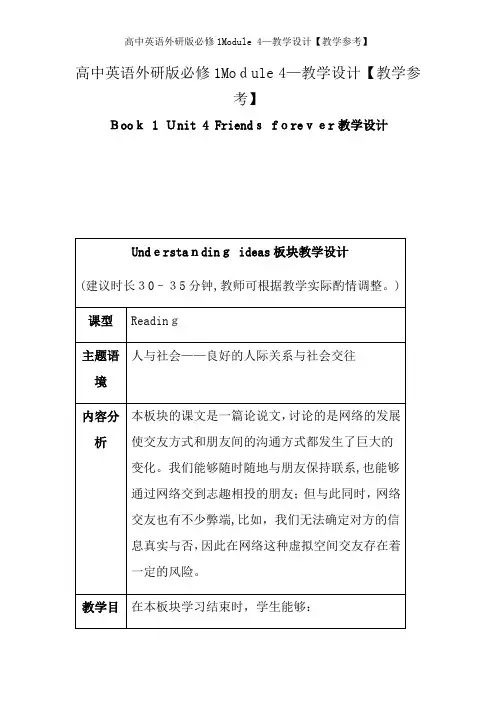
高中英语外研版必修1Module 4—教学设计【教学参考】Book 1 Unit 4 Friends forever教学设计小蝌蚪找妈妈教学设计教学目标:1、知识目标:知道小蝌蚪变成青蛙的过程;2、能力目标:培养学生正确、流利、有感情的朗读课文的能力;培养学生大胆表演、质疑、想像、表达的能力;3、情感目标:了解青蛙是益虫,懂得保护青蛙。
重点难点:重点是了解小蝌蚪变成青蛙的过程;难点是分角色朗读和表演。
教具准备:头饰、课中操音乐多媒体课件教学过程:一、谜语导入,激发兴趣:亲爱的同学们,上课之前,老师先请大家猜一个谜语:1、小黑鱼,滑溜溜,圆圆脑袋长尾巴,池塘里面游呀游。
板书:小蝌蚪2、绿衣小英雄,田里捉害虫,冬天它休息,夏天它捉虫。
板书:青蛙3、小蝌蚪和青蛙之间是什么关系呢?板书:妈妈4、今天,我们就来学一个非常有趣的故事。
板书:找齐读课题:小蝌蚪找妈妈二、观看动画,理清思路:1、先请大家看这篇文章的动画片。
2、这篇课文讲了一件什么事?(1)这篇课文主要讲的是:小蝌蚪去找她的妈妈,先碰到了鲤鱼,又碰到了乌龟,最后才找到了他们的妈妈青蛙。
(2)这篇课文主要讲的是小蝌蚪怎样变成青蛙的故事。
找鲤鱼乌龟变并在田字格里指导学生写“变”字三、配乐朗读,初步感知:1、师配乐范读,学生回答:这篇课文有几个自然段?在书上标出。
2、学生配乐按自然段接读课文后,认读二类字。
灰黑色迎上去阿姨头顶披着鼓着3、小蝌蚪是怎样变成青蛙的?板书:长出后退长出前腿尾巴变短四、研读课文,理解内容:1、那蝌蚪是什么样?学习第一段帯动作表演读,突出小蝌蚪的特点,增加趣味性,加深对蝌蚪外形的认识。
2、青蛙什么样?学习第四段:采用换角色自述的方式,让孩子们进一步加深对青蛙外形的认识。
如——例:我是一只大青蛙,我头上鼓着一对大眼睛,披着碧绿的衣裳,露着雪白的肚皮,四条腿,宽嘴巴。
3、跳课中操《小青蛙找家》4、指导写“披”字5、采用分角色朗读、帯头饰表演等形式分别学习二、三、五段。
Teaching Plan for Module 4(SEFC Book 1)The Second Period,Reading and vocabulary:“A Lively City”I. Teaching Objectives1。
Language Objectives(1) Important words and phrasesDistrict,shopping malls,harbour,architecture,lively,attractive,gorgeous(2) Important sentence patternsa.This is one of the most attractive places I’ve been to.b.It’s so lively, and everyone seems so friendly.c.pretty hot and wet in the summer, but it can be quite cold in the winter.d.This is the business district. They have put up a lot of high-rise buildings recently。
Andthere are some great shopping malls。
e.It’s a gorgeous island with some really interesting architecture.f.We are entering the western district,the most interesting part of the city.It’s got somepretty parks……2. Ability Objectives(1)learn about the ability of self-learning.(2)learn about the ability of listening and grasping the information.(3) learn how to introduce a place by using some informations.3。
The Second PeriodThe General Idea of This PeriodIntroduce the city of Xiamen. The students will get to know where it is located. What about the climate and some other information.Teaching Aims1. Learn and master the following words and expressions:hometown, attractive, lively, seem, fortunate, pretty, a lot of tourist around, brother, nuisance, business district, put up, shopping malls, approach the harbor, gorgeous, architecture, starve, apartment block2. Train the students’ reading ability.3. The students will be able to know something about the city of Xiamen.Teaching Important Points1. Learn to use some useful expressions:I’m so glad you could come.What’s the climate like?That sounds great.2. Train the students’ reading ability.Teaching Difficult PointHow to help the students understand the text.Teaching Methods1. Fast reading to get a general idea of the text.2. Asking-and-Answering to help the students understand the text.3. Pair or group work to make every student work in class.Teaching Aids1. the multimedia2. the blackboardTeaching ProceduresStep 1 GreetingsGreet the whole class as usual.Step 2 RevisionAsk the students some questions. Then show the following questions and get the students to work in pairs.1. How big is your house?2. Where is your house located?3. Is it close to your school?4. Is it close to your parents’ places of work?5. Do you like the neighbourhood?6. Do you have good neighbors?7. Are there parks or other public facilities nearby?8. Is there good public transportation?9. Are their markets and shops nearby?Ask several pairs to report their answers.Suggested answers:1. My house is very big. It’s about more than 140 square metres. There is abig drawing room,a dinning room, a study and three sitting rooms.2. My house is located in the downtown of the city.3. Yes, it is.4. It’s near to my mother’s work place but my father’s is very far.5. Yes, I like it very much. It’s clean and beautiful.6. Yes. They are very kind and friendly. They often help each other.7. Yes. There are gyms, beautiful parks and some other facilities.8. Yes, it’s convenient.9. Yes. There are many supermakets nearby.Step 3 PresentationT: Today we are going to learn a dialogue between Xiao Li and John Martin.First let’s learn some new words. (Show the words on the screen give the students a brief introduction, and then let Ss read them after the tape.)hometown, attractive, lively, seem, fortunate, pretty, a lot of tourist around, brother, nuisance, business district, put up, shopping malls, approach the harbor, gorgeous, architecture, starve, apartment block, be made of(Then get the Ss to make sentences with the words or phrases. For example)1. hometown: Xuzhou is my hometown.His hometown is Shanghai.2. attractive adj. (attract v. attraction n.)There are a lot of attractive places in this country.3. a lot of tourists aroundIn my hometown there are a lot of tourists around every day.4. be made of/from, be made into成品+be made of+材料(本质不变)成品+be made from+材料(本质变)材料+be made into+成品e. g. Wine is made from grapes.Grapes are made into wine.The table is made of wood.T: Now let’s look at this picture.(Show the picture of Gulangyu Island. ) T: Is it beautiful?S: Yes.T: Do you know where it is?S: Sorry.(...)T: OK. Listen to the tape about the place and try to get as much information as possible about this place. you’ve to answer me some questions.(Play the tape. After playing, ask the questions.)T: Where is John Martin visiting?S: Xiao Li’s hometown.T: Very good. Where does Xiao Li live?S: He lives in Xiamen.T: Excellent! What are John and Xiao Li doing now?S: They’re driving around the city in the car.T: Good! Who can tell us which place they are going to visit next?S: Gulangyu Island.Step 4 ReadingT: OK. Now open your books. Look at the dialogue on Page 32.Please practise the dialogue in pairs.(After a while, Get the students to look at these statements. Say “true” or “false” according to the dialogue.)1. John and Xiao Li haven’t seen each other for six years.()2. John has never been to China before.()3. Xiao Li enjoys living on the coast.()4. There are very few tourists in the northwest of Xiamen.()5. There are a lot of new high rise buildings in Gulangyu Island. ()6. There are some interesting buildings on Gulangyu Island. ()Step 5 Practice(Get the students to read the dialogue aloud. Then get the students to work in pairs. Close the textbooks and answer some questions.)T: Please discuss the questions in pairs.1. What do you know about Xiamen?2. Would you like to live in Xiamen? Why or why not?(After a while get several pairs to report their answers.)S: What do you know about Xiamen?S: I know Xiamen is on the coast. It’s a beautiful city.S: Would you like to live in Xiamen?S: Yes.S: Why?S: Because I like water. I like sea. There are some great shopping malls. I can buy more beautiful dress. I can often go to Gulangyu Island. It’s a gorgeous island with some really interesting architecture.T: Wonderful. Let’s look at these sentences. Discuss in groups of four.(Show)I’m so glad you could come.What’s the climate like?That sounds great.(If necessary, give some explanation.)Step 6 HomeworkT: Today we have learned a dialogue about Xiamen. It’s very interesting. After class you should read the dialogue again and again. And remember the new words.Reading A Lively City1.hometown Xuzhou is my hometown.His hometown is Shanghai.(扩展:homework homeland homesick homelike homemade)2. attractive There are a lot of attractive places in this country.(扩展:attract v. attraction n.)3. A lot of tourists In my hometown there are a lot of tourists around every day.aroundThe news got like a prairie fire.Step Ⅷ Activity and InquiryXiamen My hometownSimilarities climate It’s hot and wet in summer. It rains a lot in summer.position Both are on the coast.Differences climate In winter it is mid. Butsometimesit can be very cold.It’s very cold in winter. Every yearit snows a lot. We skate on real ice.position It’s a big open city.There are alot of tall buildings.There aremany tourists around.It’s in the countryside. There are few tourists. But it’s also beautiful. Everywhere is clean. The air is fresh希望对大家有所帮助,多谢您的浏览!。